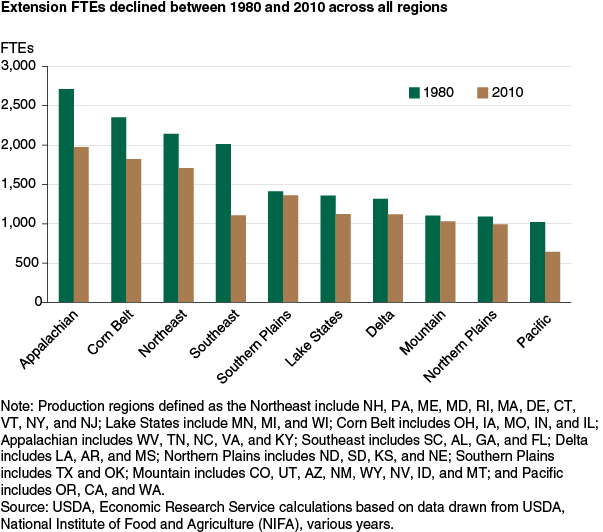Extension Faces Challenges Entering Its Second Century
- by Sun Ling Wang
- 9/8/2014
In 1914, the Smith-Lever Act created a national Cooperative Extension System (Extension) that established partnerships between USDA, State land-grant universities and other institutions, and local partners (city or county governments), with the goal of promoting U.S. agricultural productivity growth and improving rural life. Extension's role has varied through time and across regions. In recent decades, Extension has relied increasingly on State and local support. The overall State share (including all funding within State) of total Extension funding increased from about 60 percent in the early 1970s to nearly 80 percent in recent years (2007-2012). However, the levels of total Extension spending as well as the total number of Extension full-time equivalent (FTE) staff people are quite diverse across production regions.
Total Extension spending in constant dollars has declined since the 1980s, leading to declining full-time equivalent (FTE) staffing levels. Across 10 USDA production regions, the Appalachian, Corn Belt, and Northeast regions have the highest Extension FTEs in both 1980 and 2010. Total FTEs declined by 20-30 percent between 1980 and 2010 in those regions, greater than those in most other regions. Tightening budgets and varied natural resources have led to diverse Extension portfolios in each State. On average, in 2010 about a quarter of total FTEs were dedicated to the sustainable agricultural systems program, and another quarter to the family and consumer sciences program. The Lake States and Corn Belt regions dedicated a larger share (about one-third) to the family and consumer sciences area, while the Pacific region dedicated nearly 40 percent of its FTEs to the sustainable agricultural systems program.
Based on USDA statistics, by 2011, total U.S. agricultural production was more than 2.5 times its 1948 level. With aggregate agricultural inputs growing by only 4 percent during this time, productivity growth accounted for nearly all growth in agricultural output. Increasing productivity can benefit farmers and improve the rural economy. Yet, the pace of productivity growth was uneven across States. While research investment (R&D) is the major driver of productivity growth, Extension programs can also help improve farm productivity by helping farmers to adopt the most up-to-date techniques and practices. ERS researchers found that for each 1-percent increase in Extension density (Extension FTEs per farm), farm production costs declined by 0.25 percent. There is also evidence that a higher Extension density can enhance the effects of public R&D investment on a State’s productivity growth.
Meeting growing global demand for affordable food and fiber without overburdening natural resources requires continuing growth in global agricultural productivity. Public and private investments in both R&D and Extension-type activities can help support continuing U.S. agricultural productivity growth.
This article is drawn from:
- Agricultural Productivity in the United States. (n.d.). U.S. Department of Agriculture, Economic Research Service.
- Cooperative Extension System: Trends and Economic Impacts on U.S. Agriculture. (2014). Choices, Vol. 29, No. 1 (1st Quarter).
- 'Accounting for the Impacts of Public Research, R&D Spill-ins, Extension, and Roads in U.S. Agricultural Productivity Growth” . (2012). in Agricultural Productivity: An International Perspective, CABI.


